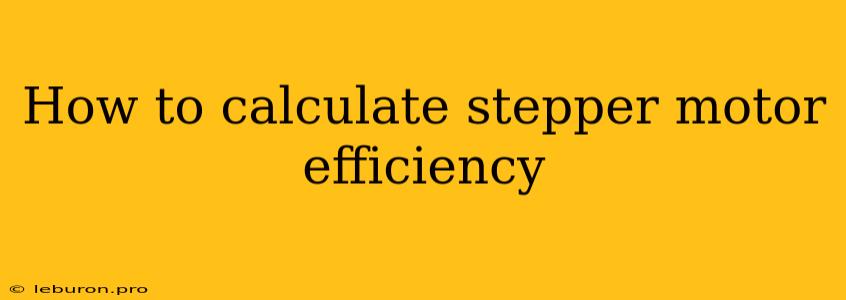Stepper motors are a type of electric motor that rotates in discrete steps, making them ideal for applications requiring precise positioning and control. Understanding how to calculate stepper motor efficiency is crucial for optimizing system performance and selecting the right motor for your application. This article will delve into the factors that influence stepper motor efficiency, explore various methods for calculating it, and provide insights into maximizing efficiency for optimal operation.
Understanding Stepper Motor Efficiency
Stepper motor efficiency refers to the ratio of mechanical power output to electrical power input. In other words, it measures how effectively the motor converts electrical energy into rotational motion. Calculating stepper motor efficiency involves considering several factors, including the motor's design, operating conditions, and load characteristics.
Factors Affecting Stepper Motor Efficiency
- Motor Design: The design of the stepper motor significantly impacts its efficiency. Factors such as the number of phases, winding resistance, and magnetic material used all contribute to the motor's power conversion capabilities.
- Operating Conditions: Environmental factors like temperature and humidity can affect efficiency. Extreme temperatures can lead to increased resistance and reduced motor performance.
- Load Characteristics: The type and magnitude of the load placed on the motor directly influence its efficiency. Higher load requirements generally lead to lower efficiency.
- Operating Speed: The speed at which the motor operates can also impact efficiency. Stepper motor efficiency tends to decrease at higher speeds due to increased friction and losses.
- Torque Production: The amount of torque produced by the motor is directly related to its efficiency. Higher torque requirements generally lead to lower efficiency.
- Winding Resistance: The resistance of the motor windings affects the amount of electrical energy converted into mechanical power. Lower winding resistance leads to higher efficiency.
- Back EMF: Back electromotive force (EMF) is generated when the motor rotates. This EMF opposes the applied voltage, leading to some energy loss.
- Iron Losses: Iron losses occur due to the magnetization and demagnetization of the iron core within the motor. These losses can vary depending on the motor's design and operating conditions.
- Friction: Friction within the motor's bearings and other moving parts contributes to energy loss. Minimizing friction through proper lubrication and bearing selection can improve efficiency.
- Copper Losses: Copper losses are a result of the current flowing through the motor windings. These losses are proportional to the square of the current.
Methods for Calculating Stepper Motor Efficiency
Calculating stepper motor efficiency can be approached using various methods, each with its own level of complexity and accuracy.
1. Using the Power Formula
A fundamental method for calculating stepper motor efficiency involves using the power formula:
Efficiency = (Mechanical Power Output) / (Electrical Power Input)
- Mechanical Power Output: This is the power delivered to the load, which can be calculated as Torque x Angular Velocity.
- Electrical Power Input: This is the electrical power consumed by the motor, which can be determined by measuring the current and voltage supplied to the motor.
2. Utilizing Motor Data Sheets
Many manufacturers provide detailed data sheets for their stepper motors. These data sheets often include information on the motor's efficiency under specific operating conditions. This method provides a convenient and generally accurate estimate of efficiency.
3. Empirical Testing
For precise efficiency calculations, empirical testing is often necessary. This involves measuring the motor's power output and input under specific load and speed conditions. The efficiency is then calculated using the power formula described above.
Maximizing Stepper Motor Efficiency
Several strategies can be employed to maximize stepper motor efficiency and optimize system performance.
1. Optimize Motor Selection
Choosing the right stepper motor for the application is crucial. Consider the required torque, speed, and operating conditions to select a motor that meets your needs while minimizing energy consumption.
2. Reduce Load Requirements
Minimizing the load placed on the motor can significantly improve efficiency. If possible, use lighter materials, streamline designs, and reduce friction to reduce the torque demands on the motor.
3. Ensure Proper Lubrication
Regularly lubricating motor bearings can minimize friction and improve efficiency. Use appropriate lubrication methods and materials based on the motor's specifications.
4. Control Operating Speed
Operating the motor at its optimal speed can maximize efficiency. Avoid running the motor at speeds significantly above or below its rated speed.
5. Monitor Motor Temperature
High operating temperatures can lead to decreased efficiency. Implement cooling strategies like fans or heat sinks to maintain optimal operating temperatures.
6. Utilize Efficient Drivers
The motor driver plays a crucial role in stepper motor efficiency. Select drivers with low switching losses and minimal current ripple to minimize energy waste.
7. Consider Pulse Width Modulation (PWM)
PWM techniques can be used to control the motor's speed and torque while optimizing energy consumption. This approach involves switching the motor's supply voltage on and off at high frequencies to regulate its power output.
Conclusion
Calculating stepper motor efficiency is essential for understanding motor performance, selecting the right motor for your application, and maximizing system efficiency. By considering factors like motor design, operating conditions, and load characteristics, you can accurately assess the efficiency of your stepper motor and implement strategies to optimize its performance. By following the guidelines outlined in this article, you can improve the efficiency of your stepper motor system and reduce energy consumption, contributing to a more sustainable and cost-effective operation.
